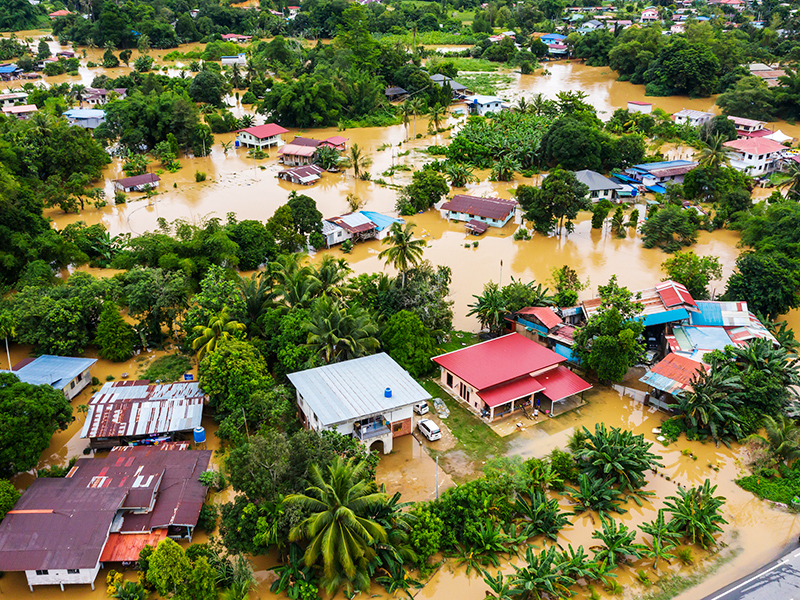
Authors
-
Samantha Harris
Former Associate Director, BSR
-
Denielle Harrison
Former Manager, BSR
South Africa is the 30th driest country in the world, and it is currently experiencing the worst drought in more than 100 years. This was apparent to us in Cape Town as soon as we walked through the airport, which has beautifully artistic but sobering signage displaying the reality of drought in the Cape. The message was further reinforced at local hotels that used creative displays to educate guests on water conservation techniques to endure the prolonged drought. Climate change is expected to further intensify this water shortage, increasing climate risk to businesses.
Aside from drought, the country is exposed and vulnerable to climate change from flooding, extreme weather events, and wildfires. Moreover, climate change will worsen additional underlying social, political, and economic vulnerabilities, including the years of political instability and lack of rights for marginalized populations, making it difficult for organizations to operate as usual.
To discuss what these issues mean for business, BSR worked with our South African partners National Business Initiative (NBI) and KudosAfrica to convene South African companies and other stakeholders in June. We presented our private-sector climate risk and resilience framework, and we sought to learn more about climate risk in the region and specifically how companies are building climate resilience strategies in an effort to cope.
Climate risk can span all aspects of business, from operations, human resources, finances, and raw materials procurement to marketing, sales, and legal. The good news is that many companies in South Africa are already assessing their climate risk and developing associated strategies to enhance the resilience of their own operations, supply chains, and local communities.
Incorporating climate risks in standard business practices is essential to adequately manage risk and build resilience across a company. A starting point is the enterprise risk management (ERM) assessment; however, integration with corporate strategic planning and specifically broadening the planning time horizon are critical to actively managing unavoidable climate risks that may have severe implications.
Overlooking these risks can impact business. Failure to manage and build resilience to climate risks impacting local communities could result in a depleted workforce. Similarly, failure to identify and build resilience against climate risks and extreme weather events can result in supply chain disruptions that can hinder or halt a company’s ability to produce its products and result in significant loss of revenue, decreased stock prices, and reputational damage.
Emerging best practice is to place a climate lens on the existing ERM frameworks companies already complete so that these potential impacts are captured. When it comes to taking this comprehensive approach to risk management, South African companies across industries are leading the way:
- Chemicals and Energy: Sasol, in an effort to not re-invent the wheel, integrates potential climate risks into its already well-developed ERM. This allows them to be addressed at business unit, functional, and process portfolio levels within the company. The resulting insights have allowed Sasol to align climate risk and financial implications, and in turn begin developing a resilience strategy.
- Extractives: Exxaro considers operational, economic, social, and environmental risks in its ERM, which allows it to use a more holistic approach to addressing climate risk and resilience. This approach addresses underlying vulnerabilities, which climate change could further exacerbate.
- Consumer Sectors: Woolworths South Africa has identified its suppliers as the source of most of its climate risk. It has therefore designed initiatives that boost suppliers’ resilience through the Farming for the Future initiative and Ceres Water Stewardship project.
- Financial Services: Santam, an insurance company, decided that instead of increasing the price of insurance, it would invest in community resilience projects after noticing an increase in insurance claims due to climate-related events. Addressing the underlying vulnerabilities has additional benefits, such as building community resilience to climate change and strengthening public and private organization engagement with local communities.
These companies have business-forward climate risk and resilience strategies that reach beyond infrastructure to vulnerable communities. While these methodologies may seem hyper-local, in practice, companies—from SMEs to multinationals—can learn valuable lessons from the work being done in South Africa.
BSR’s multisector climate risk and resilience framework includes assessing climate risks across a business, through its supply chain and within vulnerable communities in which companies operate. Building upon existing risk management systems and programs, BSR works with companies to integrate climate risk and resilience strategies.
Are you looking to better understand the impacts of climate change across your value chain? We’d be thrilled to discuss opportunities to help you identify and manage climate risks and opportunities.
BSR’s latest sustainability insights and events straight to your inbox.
Topics
Let’s talk about how BSR can help you to transform your business and achieve your sustainability goals.







